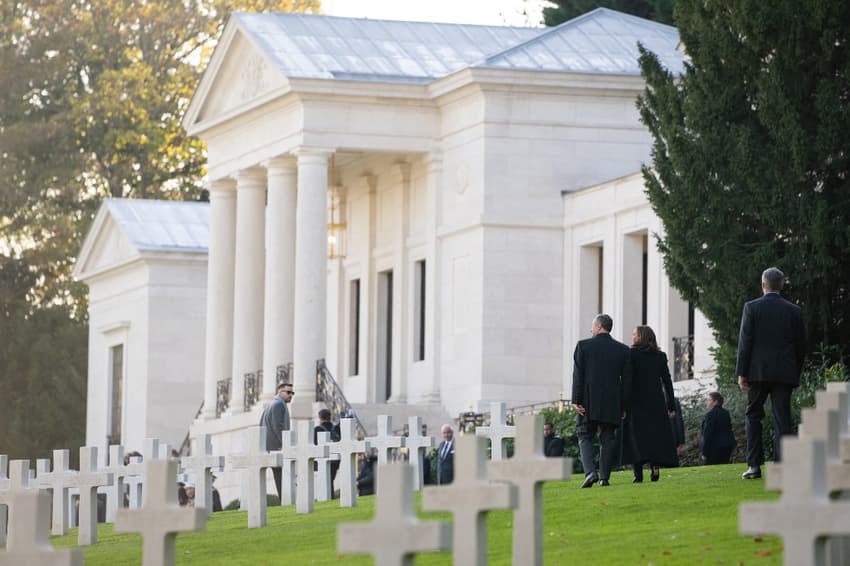American cemetery in Paris region to light up on Monday night

One of a dozen American military cemeteries will light up outside of Paris on Monday night, in tribute to the 100th anniversary of the creation of the American Battle Monuments Commission. All visitors are welcome.
Just eight kilometres to the west of Paris, the Suresnes American Cemetery - one of the 12 American cemeteries located in mainland France - will host a vigil on Monday night, to honour of the 100th anniversary of the creation of the American Battle Monuments Commission.
The cemetery will be lit up, with candles laid on each of the 1,565 headstones.
The event will begin at 7pm and it will run until 9pm. All visitors are welcome.
The vigil will commemorate the American Battle Monuments Commission, which was established by the US Congress in 1923, as part of the Federal Government tasked with designing, constructing, operating and maintaining permanent American cemeteries and monuments in foreign countries.
Earlier in the weekend, other American military cemeteries across France - namely the Normandy cemetery where 9,386 American soldiers who lost their lives during D-Day and subsequent operations are buried - conducted their own celebrations for the centennial. In Normandy, on Saturday, the cemetery also placed candles on each headstone, and lowered the flag in remembrance of those buried.
READ MORE: Oldest allies: The best and worst moments of the French-American relationship
As for the Suresnes Cemetery, it is the only American military cemetery where soldiers from both the First and Second World War are buried. It is also one of two American military cemeteries in the Paris region - the other being Lafayette Escadrille Memorial Cemetery, in Saint-Cloud Park.
In recent years, it has been visited by several American politicians, from President George W. Bush in 2009 to President Donald Trump in 2018 during the 100th year anniversary of the 1918 Armistice.
In 2021, Vice President Kamala Harris also toured the site.
The vigil on Monday night will be one of the few times of year that the cemetery is allowed to be open at nighttime.
The burial ground and memorial is located on Boulevard Washington in Suresnes (Hauts-de-Seine), on the slope of Mont Valérien facing Paris where visitors can gaze with a panorama view of the city of Paris.
For those looking to take part in the event, but are unable to travel, it will be covered live on ABMC’s Facebook page, as well as on Twitter and Instagram under the username @usabmc. You can find more information HERE.
Comments
See Also
Just eight kilometres to the west of Paris, the Suresnes American Cemetery - one of the 12 American cemeteries located in mainland France - will host a vigil on Monday night, to honour of the 100th anniversary of the creation of the American Battle Monuments Commission.
The cemetery will be lit up, with candles laid on each of the 1,565 headstones.
The event will begin at 7pm and it will run until 9pm. All visitors are welcome.
The vigil will commemorate the American Battle Monuments Commission, which was established by the US Congress in 1923, as part of the Federal Government tasked with designing, constructing, operating and maintaining permanent American cemeteries and monuments in foreign countries.
Earlier in the weekend, other American military cemeteries across France - namely the Normandy cemetery where 9,386 American soldiers who lost their lives during D-Day and subsequent operations are buried - conducted their own celebrations for the centennial. In Normandy, on Saturday, the cemetery also placed candles on each headstone, and lowered the flag in remembrance of those buried.
READ MORE: Oldest allies: The best and worst moments of the French-American relationship
As for the Suresnes Cemetery, it is the only American military cemetery where soldiers from both the First and Second World War are buried. It is also one of two American military cemeteries in the Paris region - the other being Lafayette Escadrille Memorial Cemetery, in Saint-Cloud Park.
In recent years, it has been visited by several American politicians, from President George W. Bush in 2009 to President Donald Trump in 2018 during the 100th year anniversary of the 1918 Armistice.
In 2021, Vice President Kamala Harris also toured the site.
The vigil on Monday night will be one of the few times of year that the cemetery is allowed to be open at nighttime.
The burial ground and memorial is located on Boulevard Washington in Suresnes (Hauts-de-Seine), on the slope of Mont Valérien facing Paris where visitors can gaze with a panorama view of the city of Paris.
For those looking to take part in the event, but are unable to travel, it will be covered live on ABMC’s Facebook page, as well as on Twitter and Instagram under the username @usabmc. You can find more information HERE.
Join the conversation in our comments section below. Share your own views and experience and if you have a question or suggestion for our journalists then email us at [email protected].
Please keep comments civil, constructive and on topic – and make sure to read our terms of use before getting involved.
Please log in here to leave a comment.